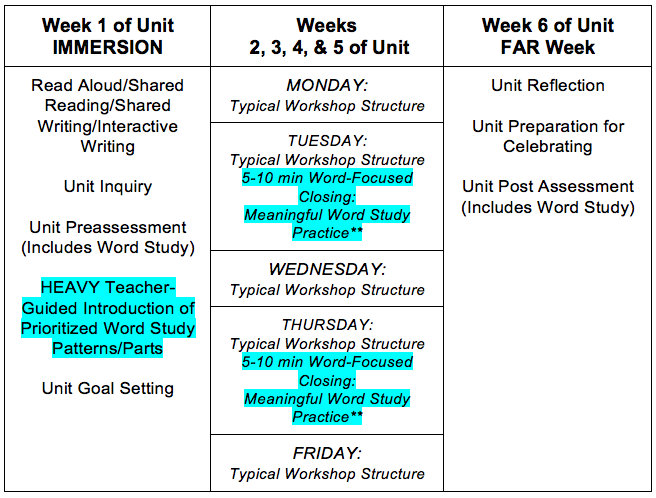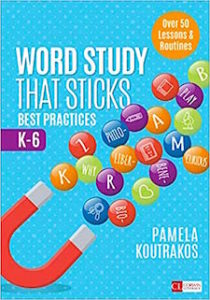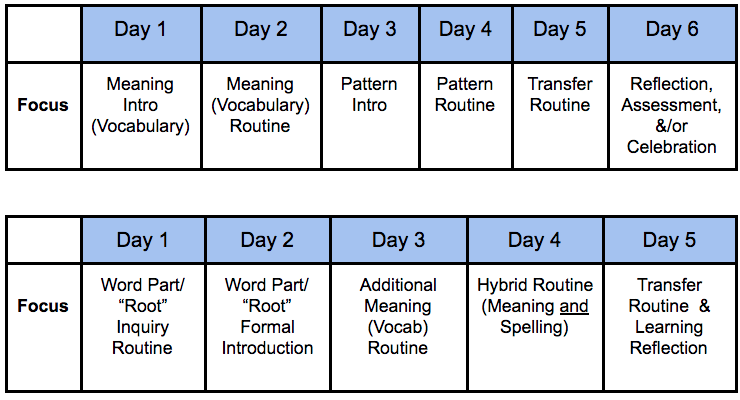3 Meaningful Ways to Boost Your Word Study
 By Pam Koutrakos
By Pam Koutrakos
We start the year with the best of intentions. We have a plan. We think, this year, I will find the time for creative, robust word study. And yet somehow, as each week and month whizzes by, we find ourselves in the same place: frustrated.
Our upper elementary and middle school students are “still” not spelling conventionally or using rich vocabulary. We may even blame smartphones, social media, and climate change. But in our most honest moments, we might also admit that perhaps we haven’t done enough to support word learning beyond providing that very vague reminder to “Check your work.”
Well, the good news is that we can jump-start word study at any point in the year, and when it comes to studying words, a little goes a long way. Although we may be more confined to minutes, periods, or blocks than our primary grade counterparts, it’s still possible to steal enough time to nourish students’ word savvy.
I’m not talking about a pie-in-the-sky goal that is actually a “go big or go home” recipe for disappointment. Instead, aim for a few consistent and flexible minutes, and build from there. To that end, what follows are three meaningful ways to work in word study.
1. Think in Cycles (not Monday-Friday)
School days are laden with disruptions. Assemblies, drills, state testing…the list goes on and on. When I tried to use a Monday-Friday model for word study, I’d invariably hit the end of the week and feel as though I hadn’t gained enough ground. At all.
Somehow I fought through the proverbial dip and shifted to using word study cycles in lieu of the traditional Monday-Friday schedule. This was one of those lightbulb moments in my teaching career that made a tremendous difference. Here are two examples to provide greater vision and clarity:
Since making the shift, I have created countless cycles that match the goals of classroom learners and include the different facets of word study. These cycles are often composed of 5-7 days and during each cycle, students work with a particular pattern, set of Greek or Latin roots, or set of words. If you have eight minutes per session, great. Fifteen or even twenty minutes? Even better.
The point: These cycles fit any time frame available.
Additionally, when I could only dedicate every-other-day to word study, cycles made this okay: Monday was day 1, Wednesday day 2, Friday day 3, the following Monday, day 4…. When I had daily time to explore words, but frequent interruptions, we could “freeze” word study whenever needed and pick up right where we left off the following day. Word study cycles work well in all grades.
2. Hijack Immersion Week
Like the idea of cycles but still feeling unsure there’s enough time? Think about a particular week that offers some flexibility. If you teach with a workshop model, immersion week is a fantastic time to introduce new vocabulary, spelling patterns, and word parts. It’s a flexible time by design, when you can heighten students’ interests and introduce goals in all sorts of ways.
If you aren’t familiar with immersion week, the key highlights of it are as follows. Immersion weeks kick off a unit of study. It’s a time when students get a chance to go deep in the unit’s genre, topics and goals before learning and practicing the “how” behind the skills and strategies inherent in the unit.
Many times this immersion is accomplished through more playful, inquiry-driven learning routines where students collaborate, play, tinker, and discover. This is also the time for more high-scaffold learning practices where we provide vision for the upcoming work of the unit.
With that in mind, take a look at the following chart to get a sense of how you might introduce and then fold in word exploration in 5-10 minute stints twice a week. And for all you time-pressed middle school teachers, I devised the schedule to work for you too.

**Some classes like to reverse this schedule on Tuesdays and Thursdays, doing word study FIRST so it does not get bumped. Click to enlarge.
50-55 minute period breakdown:
First 10-15 Minutes: Read Aloud, Mini-lesson, or Shared Reading (Teacher-Directed Structure)
Next 30 Minutes: Independent Reading with Conferring and Strategy Groups
Last 10 Minutes: Monday/Wednesday/Friday: Partner Time/Club Time/Teaching Share Tuesday/Thursday: Word Study Practice
3. Walking the Walk of Word Curiosity
As I said at the outset, it’s the quality – not the quantity – that counts. Thirty seconds here, five minutes there… it all adds up and over time makes a huge difference to students’ word acquisition and appetite for all language in general.
Additionally, when teachers mention words regularly, students see and sense that being curious about language is a real stance in the world. By wondering about words and how they work whenever you come across one that piques your interest – in a book, a newspaper, a conversation – students come to admire your curiosity.
Students can become curious themselves and invested in these pursuits – but they need to see the mindsets and the strategies modeled. Here is a starter list of quick and easy ways to infuse word learning, even when the focus of the instruction is not specifically on words.
- Visually post studied patterns, word parts, or words. By seeing them, everyone is more likely to use them.
- Notice and react to words as you read aloud to students and/or discuss recently read novels. Kate DiCamillo, Jacqueline Woodson, and Aisha Saeed, like so many other middle grades authors, write each page with beautiful and poetic language that begs us to sit up and take notice.
- During “turn and talks” and partner discussion time, challenge students to incorporate targeted vocabulary words, pattern words, or “root” words as much as possible. Tally the total – then share and celebrate.
- Add more word-themed work to each cycle of shared reading – and yes, shared reading works in all grades! You might consider shared reading sessions focused on discussing nuanced meanings of words, clarifying meaning of words with known roots, or noticing and analyzing author word choice.
- Model for students that we need to remember and apply word learning whenever we write. Co-compose a mentor text as a class. Invite students to participate by sharing ideas and coming up with conventionally spelled, prioritized, high frequency words, pattern words, or words with identified word parts (Greek and Latin roots). This can be during a literacy block, or in any subject area. This kind of interactive writing can also support confident and conventionally written content area processes like open-ended math responses, science lab reports, social studies analyses, etc.
- Incorporate what I like to call “80 second edits” at the end of the period two or three times a week. Challenge students to reread recently written work and check spelling. Editing needs to happen consistently, not just before we publish or submit work. These short, sweet, and consistent efforts help build a habit of rereading and editing!
Word study can be all these things: flexible, research-backed, engaging, time-sensitive, efficient, practical, and sticky for learners. My recent Corwin book says “K-6” on the cover, but you’ll find ideas for 7-8 there too.

Pam is the author of Word Study That Sticks: Best Practices K-6 (Corwin, 2018); The Word Study That Sticks Companion: Classroom-Ready Tools for Teachers and Students, K-6 (Corwin, 2019). and Mentor Texts That Multitask: A Less-Is-More Approach to Integrated Literacy Instruction, K-8. Connect with Pam on Twitter @PamKou and on LinkedIn.
Feature image: Phillip Martin.





































I love this! My husband often jokes that teachers “are afraid to dip their toe into the vocabulary pool for fear of being sucked under.” Teaching vocab can seem like a HUGE thing. Your tips for simple integrated practices are wonderful.
Thanks so much for your feedback! Much appreciated.